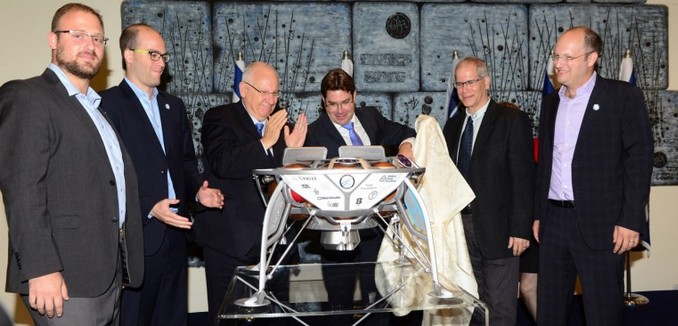Israel’s SpaceIL, one of only five teams remaining in the multi-million-dollar Google Lunar XPrize race to the moon, is starting to assemble the craft to be launched in 2018, according to SpaceIL CEO Eran Privman.
“We are thrilled to share with you that the various parts and components of the spacecraft are in advanced stages of manufacture in Israel and abroad,” he announced this week.
The competition began 10 years ago with 33 teams vying to be the first to soft-land a privately funded, unmanned robot on the moon, move it 500 meters across the moon’s surface and transmit high-definition video and photos back to Earth. The top prize is $20 million.
The nonprofit SpaceIL was the last to register, at the end of 2010, but was the first to secure the required launch contract.
“Six years of intensive activity, successful trials, development, manufacture and testing of all the complex systems that will be installed in the spacecraft … will allow us to realize our national mission and join the exclusive and prestigious group of superpowers that have landed on the moon to date: The USA, the former Soviet Union and the People’s Republic of China,” said Privman.
The SpaceIL craft will bring a lunar magnetometer from the Weizmann Institute of Science in Rehovot to study the magnetic fields on the surface of the moon.
“Additionally, we have acquired a new camera – one of the five cameras that will be assembled on the spacecraft,” Privman said.
“The camera is a technologically complex optic system that was developed specifically for us, and meets the requirements of the Google Lunar X Prize competition.
“Furthermore, we completed a successful test of our control sensors. The real data received from the star tracker and the IMU sensor in motion (as part of a nighttime test conducted outdoors), were injected into the navigation algorithm for the purpose of testing it. The navigation algorithm performed well, and the test in itself led to better understanding of how the sensors operate.”
The only others that have made it this far in the competition are teams from India, Japan and the United States, as well as an international team of individuals from about 15 countries. In a recent article, the National Geographic profiled the teams. The article featured fabulous photos by art photographer Vincent Fournier.
SpaceIL has a major educational component, with the aim of encouraging Israeli children to consider careers in the sciences. “Along with the lectures we give at schools on a regular basis, we have launched, in collaboration with Time to Know, an online digital platform for learning English, which also tells the story of the first Israeli spacecraft,” said Privman.
(via Israel21c)
[Photo: Israel21c ]




